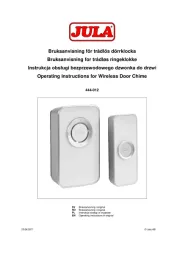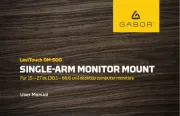Inspection/Maintenance
Inspect the Punch Head before each use for issues that could affect safe
use.
1. Remove battery from electrical tool.
2. Clean any oil, grease or dirt from the tool and head, including han-
dles and controls. This aids inspection and helps prevent the ma-
chine from slipping from your grip.
3. Inspect the head for:
• Proper assembly and completeness.
• Wear, corrosion or other damage.
• Oil Leaks. If the draw stud piston ex-
tends past the tool face (Figure 2), the
oil is low. Have the punch head serviced
– do not attempt to add oil.
• Presence and readability of head mark-
ings.
•See electrical tool manual for inspec-
tion and maintenance of the QCS cou-
pling.
If any issues are found, do not use head until corrected.
4. Inspect the electrical tool and any other equipment being used as
directed in their instructions. Make sure other knockout components
are in good working condition.
5. Lubricate the head pivot points with a light weight general purpose
lubricating oil. Wipe off any excess oil.
Set Up/Operation
These instructions are generalized for many types of knockout punches
and dies. Follow the specific instructions for the set up and operation of
the knockout punch and die being used.
1. Determine the thickness and type of material to be punched. Make
sure there is only a single thickness of material to be punched. De-
termine the hole size you wish to punch. Select the appropriate
matched punch and die set per manufacturer’s specifications.
2. Make sure all equipment is inspected and set up per manufacturer’s
instructions.
3. Mark the hole location and if needed drill a pilot hole 1/8" (3 mm)
larger than the draw stud (E.g. for a 3/4" draw stud, drill a 7/8"
(22 mm) pilot hole.)
4. Remove battery from electrical tool. Thread the draw stud com-
pletely into the Punch Head unit. The thread must be fully engaged
to ensure proper operation, but does not need to be tight.
5. Place any needed spacer(s) over the draw stud, followed by the
punch die. Place the cupped half of the die facing away from the tool.
6. Insert the draw stud through the pilot hole in the material to be
punched.
7. Thread the matching punch half of the die onto the draw stud with
the cutting edges toward the material. Tighten by hand until there
are no gaps between the head, spacer(s), die, material and punch.
If there are gaps between the parts, the dies will not be square to the
material and could damage the equipment or cause injury.
A thread adapter is available for use with punches with 11/8" - 12
threads to convert for use with ¾" - 16 UNF draw studs. Fully thread
adapter into the punch as shown in Figure 3 inset.
Figure 3 – Setting Up The Punch Head
Make sure that the punch is fully threaded onto the draw stud. Do
not operate with the punch partially threaded onto the draw stud,
this could damage the stud. If the punch will not fully thread onto
the draw stud, a spacer may need to be removed.
8. Changing Heads with QCS Coupling – See electrical tool manual.
WARNING
Read and understand
these instructions, the
electrical tool instruc-
tions, and the warn-
ings and instruc tions
for all equipment and material being used before operating this tool
to reduce the risk of serious personal injury.
SAVE THESE INSTRUCTIONS!
•Keep your fingers and hands away from the punch head during
the punch cycle. Your fingers or hands can be crushed, fractured or
amputated if they are caught between the punch dies or the compo-
nents and any other object.
•Do not use on energized electrical lines to reduce the risk of elec-
trical shock, severe injury and death. Tool is not insulated. Use
appropriate work procedures and personal protective equipment when
working near energized electrical lines.
•Large forces are generated during product use that can break or
throw parts and cause injury. Stand clear during use and wear ap-
propriate protective equipment, including eye protection.
•Do not handle punch head while punching. The punch head con-
tains high pressure oil during punching. High pressure oil escaping
from punch head can penetrate the skin and cause serious injury. If oil
is injected under the skin, seek immediate medical attention.
• A head that has been welded,Never repair a damaged head.
ground, drilled or modified in any manner can break during use. Only
replace components as indicated in these instructions. Discard dam-
aged heads to reduce the risk of injury.
If you have any questions concerning this RIDGID®product:
• Contact your local RIDGID distributor.
• Visit RIDGID.com to find your local RIDGID contact point.
• Contact Ridge Tool Technical Service Department at rtctechservic -
es@emerson.com, or in the U.S. and Canada call (800) 519-3456.
Description
The RIDGID®Swiv-L-Punch™ Head is designed for use with punches
and dies (such as knockout punches) to punch holes through sheet ma-
terials such as mild or stainless steel.
The tool is available either as an interchangeable head (For RIDGID®
RE 6/ RE 60 or ILSCO Electrical Tool) or as part of a dedicated tool
(RIDGID®RE-600 series tools).
The Punch Head can rotate and articulate 360 degrees for better access
in tight areas.
Figure 1 – PH-60C Swiv-L-Punch Head (Interchangeable version)
Specification
Material Thickness .............Mild Steel – Up to 10 gauge
(0.134", 3.4 mm)
Stainless Steel – Up to 12 gauge
(0.109", 2.8 mm)
Max. Punch Diameter Up to 5" (120 mm) in 12 gauge mild steel...........
and 14 gauge stainless steel
Up to 2" (50,8 mm) in 10 gauge mild steel
and 14 gauge stainless steel
Draw Stud Thread ................3/4" – 16 UNF
QCS Coupling Type............6T QCS and 60kN QCS
Maximum Output Force......14,600 lbf (64 kN)
Interchangeable Head
Weight 4.4 lb (2.0 kg).................................
Punching capacity depends on a variety of factors including punch
size/configuration, material thickness, type, and hardness. Holes may not
be able to be completed in all cases based on these and other variables.
PH-60C Swiv-L-Punch™ Head Instructions
QCS Coupling
¾" – 16 UNF Thread For
Draw Stud
Printed 1/17
999-999-526.09
EC42593 REV. B
©2017 RIDGID, Inc.
The Emerson logo and RIDGID logo are registered trademarks of Emerson Electric Co. or RIDGID, Inc. in the U.S. and other countries.
All other trademarks belong to their respective holders.
360° Articulation
Tool Face
Draw Stud
Piston
Figure 2 – Punch Head
Oil Low
Punch Die
Punch
Spacer(s)
(If Needed)
Material
Optional
11/8– 12
Adapter











